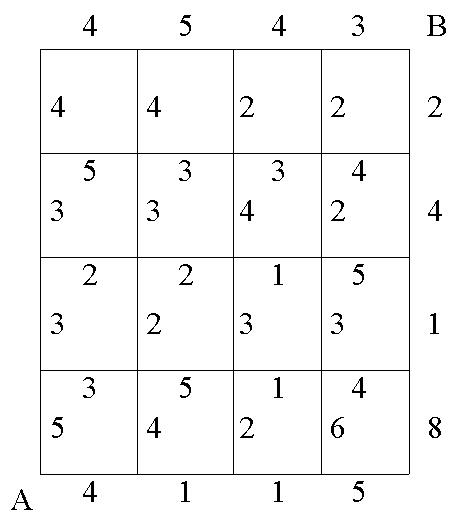b. Problème du type plus court chemin

Quel est le plus court chemin de A à B ?
Solution:
On considère l'ensemble des états les point d'intersection sur les diagonales. Ainsi on a exactement 8 étapes.
fn(S, xn) = Csxn + fn+1 (xn), n=1,...., 8
avec f*n+1 (s) = ![]() fn(S, xn) et f9 (S) = 0
fn(S, xn) et f9 (S) = 0
Etape 8
|
|
f8(S, B) |
|
||
|
x8 S |
B |
|
|
|
|
1 |
3 |
3 |
B |
|
|
2 |
2 |
2 |
B |
|
Etape 7
|
|
f7(S, x7) = Csx7+ f8( x7) |
|
|||
|
x7 |
1 |
2 |
|
|
|
|
1 |
7 |
- |
7 |
1 |
|
|
2 |
5 |
6 |
5 |
1 |
|
|
3 |
- |
6 |
6 |
2 |
|
Etape 6
|
|
f6(S, x6) = Csx6+ f7( x7) |
|
||||
|
x6 S |
1 |
2 |
3 |
|
|
|
|
1 |
12 |
- |
- |
12 |
1 |
|
|
2 |
9 |
8 |
- |
8 |
2 |
|
|
3 |
- |
7 |
11 |
7 |
2 |
|
|
4 |
- |
- |
7 |
7 |
3 |
|
Etape 5
|
|
f5(s, x5) = Csx5+ |
|
|||||
|
x5 S |
1 |
2 |
3 |
4 |
|
|
|
|
1 |
16 |
- |
- |
- |
16 |
1 |
|
|
2 |
16 |
11 |
- |
- |
11 |
2 |
|
|
3 |
- |
12 |
8 |
- |
8 |
3 |
|
|
4 |
- |
- |
10 |
11 |
10 |
3 |
|
|
5 |
- |
- |
- |
15 |
15 |
4 |
|
Etape 4
|
|
f4(s, x4) = Csx4+ |
|
||||||
|
x4 S |
1 |
2 |
3 |
4 |
5 |
|
|
|
|
1 |
20 |
16 |
- |
- |
- |
16 |
2 |
|
|
2 |
- |
14 |
10 |
- |
- |
10 |
3 |
|
|
3 |
- |
- |
11 |
11 |
- |
11 |
3,4 |
|
|
4 |
- |
- |
- |
16 |
20 |
16 |
4 |
|
Etape 3
|
|
f3(s, x3) = Csx3+ |
|
|||||
|
x3 S |
1 |
2 |
3 |
4 |
|
|
|
|
1 |
12 |
12 |
- |
- |
12 |
2 |
|
|
2 |
- |
12 |
16 |
- |
12 |
2 |
|
|
3 |
- |
- |
13 |
17 |
13 |
3 |
|
Etape 2
|
|
f2(s, x2) = Csx2+ |
|
||||
|
x2 S |
1 |
2 |
3 |
|
|
|
|
1 |
15 |
15 |
- |
15 |
1,2 |
|
|
2 |
2 |
16 |
14 |
14 |
3 |
|
Etape 1
|
|
f1(s, x1) = Csx1+ |
|
|||
|
x1 S |
1 |
2 |
|
|
|
|
A |
20 |
18 |
18 |
2 |
|
On peut résumer les résultats de la façon suivante:
|
Etapes |
1 |
2 |
3 |
4 |
5 |
6 |
7 |
8 |
9 |
|
Chemin optimal 1 |
A |
2 |
3 |
3 |
3 |
3 |
2 |
1 |
B |
|
Chemin optimal 2 |
A |
2 |
3 |
3 |
4 |
3 |
2 |
1 |
B |
La longueur du chemin optimal (1 ou 2) est égale à 18.
 Cliquer ici pour enregistrer le chapitre 7 en format Word sur votre disque dur (436 Ko)
Cliquer ici pour enregistrer le chapitre 7 en format Word sur votre disque dur (436 Ko)
![]() Pour tout commentaire envoyer un mail à hatem_masri@yahoo.com
Pour tout commentaire envoyer un mail à hatem_masri@yahoo.com